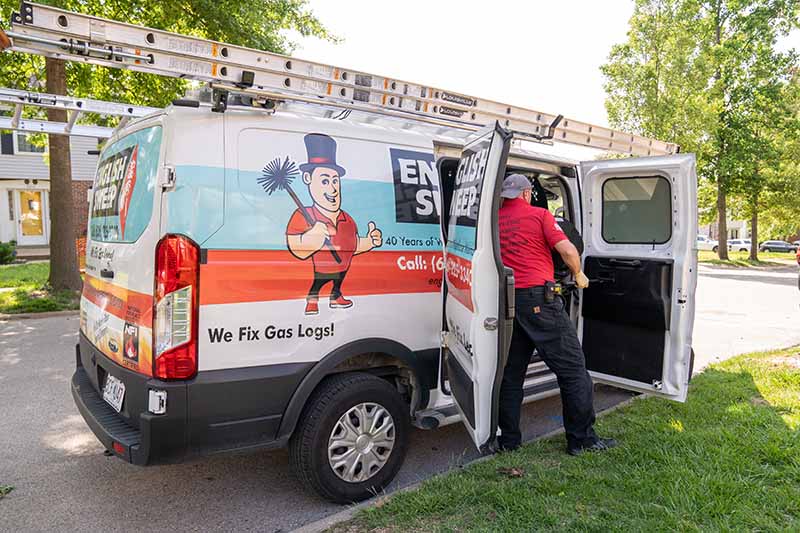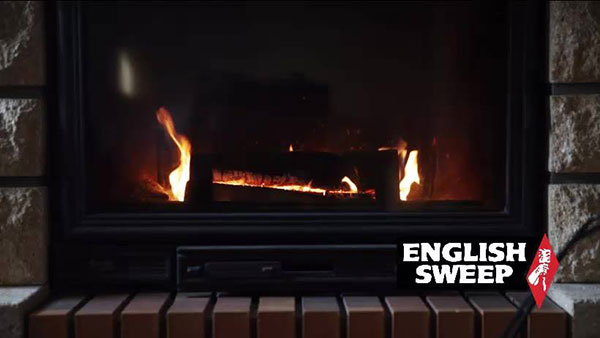For a Chimney Sweep Near You, Trust the Crew at English Sweep to Service & Sweep Your Gas Appliance
If you’ve ever owned a wood-burning appliance, then you’re likely aware that they need sweepings and servicing from time to time. Wood creates a lot of harmful byproducts that break down chimney components and lead to other hazards, like creosote buildup. So, the need for regular inspections and service is kind of a no-brainer.

But when it comes to gas appliances, many homeowners don’t realize that regular maintenance is equally important. These systems are known for their heightened efficiency, ease of use, and mess-free functioning, and many figure that professional care isn’t required. Even if homeowners do suspect that gas appliances need servicing, many don’t know what type of services they need, how often they need them, and just why professional care is such a necessity.
If you fall into the unsure category, English Sweep is here to help. If you’re a homeowner in St. Louis and you have questions about keeping your gas appliance serviced – and working as safely and efficiently as possible – reach out to us at 636-225-3340 or contact us through our website. We’re here to help.
What’s Included With Gas Appliance Maintenance by English Sweep?
When providing gas appliance maintenance and gas fireplace repair, a chimney technician from English Sweep will do all of the following during your appointment:
Inspect the gasket and assembly for leaks or breaks in the seal
Check the burner
Clean the firebox and logs, removing any dust or dirt
Inspect the firebox for damage
Clean and check the pilot light and pilot light assembly
Clean the outside of the firebox
Inspect the entire unit in accordance with NFPA guidelines and manufacturer guidelines
Check the chimney or vent for damage, debris, and blockages
Clean the glass with approved cleaners and check for scratches and breaks
Reassemble the fireplace
If we detect any issues with the system or notice any areas in need of repair or replacement, we’ll let you know during the service appointment, so you can take the next steps.
Why Do Gas Appliances Need to Be Serviced?
Gas systems aren’t fueled by burning wood, so you’re not going to see that visible soot or creosote that you see in wood-burning appliances. However, dust buildup can cause problems, and you still need a reliable chimney to vent out harmful, corrosive substances. There’s also the possibility of acidic condensation forming and causing water damage inside your flue pipe. Routine chimney cleaning and maintenance services can take care of these issues for you.
If you haven’t kept up with standard maintenance, your system will eventually start to break down, and your chances of being exposed to carbon monoxide will go up considerably.
Other issues to look out for that could indicate an issue with your gas appliance?
- Damp patches on your walls
- Blistered paint or peeling wallpaper
- Stains on the ceiling near the chimney
- Efflorescence (white stains) on your masonry
- Deterioration throughout your mortar joints
- Crumbling brickwork
All of these things indicate it’s time for professional care. The trouble is that not all issues and threats related to gas-burning systems are obvious. Sometimes even minor damage can lead to major problems, so regular inspections and maintenance services are important. Call or book with us online today.
Carbon Monoxide & Your Gas Fireplace
Carbon monoxide is both colorless and odorless making it more difficult to detect. You won’t see the gas in your space and you won’t notice that rotten egg smell that’s typically associated with gas leaks. What you can do is keep an eye out for the symptoms of exposure.
If carbon monoxide is in your home, you or others in your home may experience:
- nausea
- light-headedness
- dizziness
- chest pain
- symptoms similar to the flu
In addition, prolonged exposure can lead to unconsciousness and even death. Because of this, we strongly urge our customers to invest in carbon monoxide detectors for their homes. Nowadays, some models serve as both smoke and carbon monoxide detectors, ensuring you’re covered for any threats that may be present.
What should I do if carbon monoxide is in my home?
If you do discover carbon monoxide in your living space, your first move should be to leave the home and get out into the open air. Next, call the fire department for further assistance. If your gas appliance is indeed the issue, give our emergency number a call. We pride ourselves on keeping St. Louis families as safe as possible, and we’re here to help you out.
What Maintenance Does a Gas Appliance Need?
You may not have to worry about creosote buildup if you have a gas fireplace, gas logs, or a gas insert, but it’s still important to get your appliance checked regularly.
The Chimney Safety Institute of America (CSIA) and the National Fire Protection Association (NFPA) recommend getting your heating appliance inspected and cleaned at least once a year regardless of your preferred fuel source.
You can also schedule your annual chimney sweep when you schedule your inspection. Cleaning a gas fireplace or appliance looks a little different than sweeping a wood-burning unit. We’ll carefully remove any decorative logs and embers, and then use a special vacuum to gently remove dust, debris, and any loose particles from the fireplace’s interior.
In between annual cleanings, you should have a cleaning schedule of your own. Once a month, take a cloth or a soft brush and gently sweep away dust and soot so that vents don’t get clogged.
How Often Should I Invest in Gas Fireplace Services?
So here’s the big question many end up asking: How often do I need to schedule inspections for my gas appliances? Our simple answer is this: every year! Any stove, insert, fireplace, or other heating device you own should have an annual inspection completed – no matter the fuel type – to keep it functioning both safely and efficiently throughout those colder months.
Always play it safe by hiring a CSIA-certified chimney sweep to look things over before putting the system to use for the season. We have multiple technicians that hold this certification (the most in the area, in fact), so when you rely on us, you can be confident your system will be thoroughly evaluated and prepped for use.
When it’s time to schedule an appointment for your annual maintenance, call English Sweep at 636-225-3340 or book an appointment online.
Do Gas Fireplaces Require a Chimney or Vent?
Whether gas appliances require a chimney or vent depends on the type of gas appliance and its setup. There are several types of gas appliances, and each has specific ventilation requirements:
- Gas fireplace inserts. These are designed to be inserted into an existing wood-burning fireplace, converting it to a gas fireplace. The ventilation for gas inserts may vary depending on the installation. Some use the existing chimney to cut back on additional work, while others may use a direct-vent system if the existing chimney is not in good condition.
- Direct-vent gas appliances. Most gas fireplaces fall into this category. Direct-vent gas appliances use a sealed combustion system with a dedicated venting system. These appliances draw in air from outside through one pipe and expel exhaust gases through another pipe directly to the outdoors. They do not require a traditional chimney.
- Ventless gas appliances (vent-free). Ventless gas appliances, like ventless gas heaters and ventless gas logs, do not require a chimney or vent. These appliances are designed to burn gas in a way that produces minimal emissions, and any combustion byproducts are released into the room. Since toxins aren’t being removed from the home, ventless models usually come equipped with safety measures like oxygen depletion sensors to monitor indoor air quality.
- B-vent and natural draft appliances. Some older gas appliances, such as b-vent gas heaters and natural draft gas water heaters, use a vertical vent pipe routed through the roof. They rely on natural drafts to vent combustion byproducts and are not as efficient as direct-vent models. They may not require a full masonry chimney, but do need a venting system.
Are Gas Fireplaces Safer Than Wood-Burning Fireplaces?
Gas fireplaces and heating appliances are a popular choice for homeowners for a long list of reasons. Their efficiency and convenience are often at the top of those, with safety often being another highly cited reason.
Are the claims about gas appliances being safer true? Anytime you deal with some combination of fire and gas, there is risk involved – be it a gas unit or wood unit. You should consider the pros and cons of adding a gas appliance to your home before you make a final decision.
Here are some gas fireplace safety pros:
You can control the flames.
Gas fireplaces allow you to have close control over the size and intensity of the flames. This makes it easier to maintain a safe and comfortable environment.
No runaway sparks or embers.
Wood-burning fireplaces can give off sparks and embers that may escape the firebox, potentially causing fires or burns. Gas fireplaces do not have this issue, as they produce no burning debris.
Fewer fire hazards.
Gas fireplaces eliminate the need for storing, handling, and burning wood which reduces the risk of accidental fires caused by sparks, flying embers, or improperly extinguished fires.
Steady, reliable heat output.
Gas fireplaces provide consistent, controllable heat. Wood-burning fireplaces often fluctuate in temperature based on airflow, which can lead to inefficient heating.
No creosote, ash, and soot.
Gas fireplaces do not produce creosote, ashes, or soot like wood-burning fireplaces. This means less cleaning and maintenance. Creosote buildup is also a leading cause of chimney fires.
Here are some safety cons:
Risk of a gas leak.
Gas leaks can be dangerous and potentially fatal. If you suspect a gas leak, you should immediately evacuate the area, shut off the gas supply, and contact the gas company or emergency services.
Carbon monoxide poisoning.
Some vent-free gas appliances don’t have a way to redirect toxins out of your home. If you have a gas appliance, it’s important to install a carbon monoxide detector near the unit and an oxygen depletion sensor on the appliance itself.
You have to make sure you have proper ventilation.
Ensuring adequate ventilation and the correct venting system is crucial to prevent the buildup of combustion byproducts and carbon monoxide.
How Can You Tell if You Have a Gas Leak in Your Home?
Natural gas and propane are flammable and pose health risks when inhaled, so it’s important to be aware of any changes in your home that could point to a gas leak. Keep an eye out for the following:
There’s a “rotten egg” smell.
Natural gas and propane are odorless, but gas companies add a chemical called mercaptan that gives gas that “rotten egg” or sulfur-like odor we’ve become so familiar with. If you detect this smell, it’s a strong indicator of a gas leak.
You hear hissing.
Gas leaks may produce a hissing or whistling sound near the source of the leak. If you hear such a sound, call the authorities.
You don’t feel well.
Inhaling natural gas or propane can cause physical symptoms, such as dizziness, nausea, fatigue, headache, and eye or throat irritation. If you or your family members experience these symptoms suddenly and without another obvious cause, it’s a reason for concern.
Pilot lights are burning out.
If the pilot lights on your gas appliances, like stoves, water heaters, or furnaces, repeatedly go out or burn with a yellow or orange flame instead of blue it can indicate a gas supply issue.
If you suspect a gas leak, you need to evacuate your home immediately. Do not try to locate the source of the leak or patch it yourself. Get to a safe distance away from your house and once everyone is secure, call 911 or a gas company’s emergency line.
How Much Does It Cost to Maintain a Gas Appliance?
While we wish we could give you an estimate without knowing more about your specific appliance, we can’t. Many things can impact the cost of fireplace and chimney maintenance, so we can’t provide an estimate that will accurately reflect your needs until we know more about your appliance. These are some questions we may ask before giving an estimate:
- What type of gas appliance is it? Fireplace, gas logs, insert…?
- How old is the unit?
- Do you use natural gas or propane?
- How often do you use your appliance? Is it every day or only seasonal?
- Is it your primary heating source?
What Is the Average Lifespan of a Gas Appliance?
Assuming it was installed properly, you can expect most gas appliances to hold up for 5 to 20 years. That seems like a wide range – and it is. The truth is that how long your gas appliance lasts is very much up to you.
Are you keeping up with annual inspections and cleanings? Do you follow the manufacturer’s instructions to operate it? Do you get repairs done promptly? These all can make the difference between needing to replace a gas stove after just six years or having a gas furnace that’s still in tip-top shape after two decades.
Call Today & Book an Appointment for Your Gas Appliance Service
Do you have a gas appliance you need to be serviced? Look no further than English Sweep. We’re proud to have served the greater St. Louis area for years. If you want the best in the business, our team of CSIA-certified technicians has been resolving issues with leaky, smelly, ugly chimney systems – and making gas appliance maintenance simple – for homeowners for more than four decades.
Schedule your appointment online now or get in touch with one of our customer service representatives by calling 636-225-3340. We can’t wait to talk to you!
Don’t procrastinate when it comes to chimney repairs. Let our professional chimney services crews advise you on what needs to be done and when. We’ll take good care of you and what needs doing.

